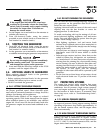
12 Generac
®
Power Systems, Inc.
Section 3 – Maintenance
QUIETPACT™ 65D Recreational Vehicle Generator
9. Remove the dipstick, and wipe it dry with a clean,
lint-free cloth. This will be used later to check the
oil level.
10. Remove the oil-fill plug, and slowly add the prop-
er type and amount of recommended oil (see
Section 1.5.3, Page 6). Periodically use the dip-
stick to check the oil level and continue to fill the
crankcase until the oil reaches the dipstick
“FULL” mark. DO NOT FILL ABOVE THE “FULL”
MARK.
11. Install the oil-fill plug and the dipstick.
12. Reinstall the air filter.
13. Reattach the front service door; make sure the
latches are fully engaged.
14. Start the engine, and check for leaks.
NOTE:
Check the oil level and fill to the “FULL” mark,
after checking for leaks. The filter will retain some
oil.
3.3 SERVICING THE ENGINE
AIR FILTER
To access the engine air filter (Figure 3.2, Page 13),
remove the front service door, located beneath the
unit, by retracting the two latches and pivoting the
door downward. Loosen the hose clamp at the base
of the air filter and remove the filter. Place the hose
clamp on the new filter and install it, making sure it
is positioned properly before reattaching the service
door. Make sure the service door latches are fully
engaged.
Figure 3.2 – Engine Air Filter
See the “Service Schedule,” Section 3.13 (Page 16),
for recommended air cleaner maintenance.
3.4 SPARK ARRESTOR MUFFLER
The exhaust muffler supplied with the QUIETPACT™
65D is a spark arrestor type. Generac exhaust muf-
flers for recreational vehicle generators do not have a
spark arrestor screen, but are of the more efficient
“toroid” or “swirl” type. To remove carbon and com-
bustion deposits from the muffler, proceed as follows
(see Figure 3.3):
1. Place the unit above a noncombustable surface,
and ensure that the generator exhaust piping is
cool.
2. Remove the two screws holding the spark
arrestor access plate to the rear floor pan.
3. Remove the spark arrestor access plate and gasket.
4. Remove the hex pipe cap from the end of the
spark arrestor cleanout pipe.
5. Thread on a 3/8” NPT pipe coupling and pipe
nipple to extend the cleanout pipe at least 10
inches (250 mm) below the rear floor pan; addi-
tional piping may be added to direct the muffler
exhaust away from the cooling air discharge flow
beneath the unit.
6. Start and run the engine for approximately 15
minutes.
7. Shut down the engine, and allow the piping to
cool.
8. Remove the 3/8” NPT coupling and piping.
9. Apply a graphite-base, anti-seize compound to
the cleanout pipe threads.
10. Reinstall the hex pipe cap, spark arrestor access
plate, gasket, and two screws.
The exhaust system of this product gets extreme-
ly hot and remains hot after shutdown. High
grass, weeds, brush, leaves, etc., must remain
clear of the exhaust. Such materials may ignite
and burn from the heat of the exhaust system.
Failure to provide and maintain a spark arrestor
may be in violation of the law. If this generator
is used on any forest-covered, brush-covered,
or grass-covered unimproved land, the vehicle
owner or operator must maintain the spark
arrestor in good condition. In the state of
California, the preceding is required by law
(Section 4442 of the California Public Resources
Code). Other states may have similar laws.
Federal laws apply on federal lands.
Be sure to reinstall the hex pipe cap tightly to the
spark arrestor cleanout pipe. Vibration could cause
a loose cap to fall out, resulting in hot engine
exhaust being drawn through the centrifugal cool-
ing fan and out beneath the unit. This could result
in damage to the generator or in discharge of hot
exhaust sparks beneath the unit.


















